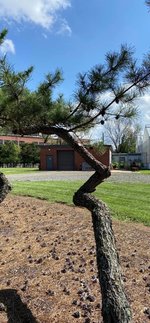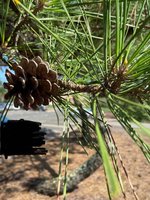You are using an out of date browser. It may not display this or other websites correctly.
You should upgrade or use an alternative browser.
You should upgrade or use an alternative browser.
Identify pine?
- Thread starter BigAbs321
- Start date
-
- Tags
- identification pine
Cruiser
Omono
Is the tree anywhere near the pine barrens or coast? If so it could be pitch pine.
What’s the general needle length? It looks like 3 needles per sheath.
Do the needles make an audible snap and come apart if you snap one? Or do they just bend?
Is there epicormic growth in the trunk or larger branches?
Are the fresher cones prickly?
What’s the general needle length? It looks like 3 needles per sheath.
Do the needles make an audible snap and come apart if you snap one? Or do they just bend?
Is there epicormic growth in the trunk or larger branches?
Are the fresher cones prickly?
Cruiser
Omono
Also, how many inches are the cones?
How flexible are the branches?
Scotch pine, Austrian, and red pine are also possibilities (if your tree has 2 needles per sheath.)
How flexible are the branches?
Scotch pine, Austrian, and red pine are also possibilities (if your tree has 2 needles per sheath.)
Potawatomi13
Imperial Masterpiece
Very insightful questionsAlso, how many inches are the cones?
How flexible are the branches?
Scotch pine, Austrian, and red pine are also possibilities (if your tree has 2 needles per sheath.)
It’s two needles per sheath, I’d say the cones are 3-4 inches when dried up. The needles are longer I think, maybe 5-6 inches? Tbh I don’t think they’re native to NJ, they were planted for landscaping. I’m just curious bc all of them have cool movement and was wondering if the species would make good bonsai.Also, how many inches are the cones?
How flexible are the branches?
Scotch pine, Austrian, and red pine are also possibilities (if your tree has 2 needles per sheath.)
PA_Penjing
Chumono
They plant a lot of Japanese black pine in NJ because they are salt tolerant. Most of the pines I see in NJ are JBP, pitch or virginia. And it's definitely not virginia. And if it doesn't have 3 needles than its not pitch.
Gotcha, thanks a bunch for clearing that up!They plant a lot of Japanese black pine in NJ because they are salt tolerant. Most of the pines I see in NJ are JBP, pitch or virginia. And it's definitely not virginia. And if it doesn't have 3 needles than its not pitch.
Cruiser
Omono
The cone and needle lengths you mention correspond more closely to Austrian pine, but PA_Penjing brings up a good point. If they plant a lot of JBP in NJ then there’s a good chance it’s that. I’d check for minute prickles on the cones, if they are pointy it’s more likely a jbp, if they’re more blunt, then it’s more likely Austrian.It’s two needles per sheath, I’d say the cones are 3-4 inches when dried up. The needles are longer I think, maybe 5-6 inches? Tbh I don’t think they’re native to NJ, they were planted for landscaping. I’m just curious bc all of them have cool movement and was wondering if the species would make good bonsai.
Either way, both seem to make good bonsai.
PS. Try snapping a needle in half. If it breaks cleanly then it probably is a red pine..
PA_Penjing
Chumono
Gotcha, sounds good thank youAustrian pine are generally a single flush pine, whereas Japanese black pine produce two flushes of growth per season, so care is different.



